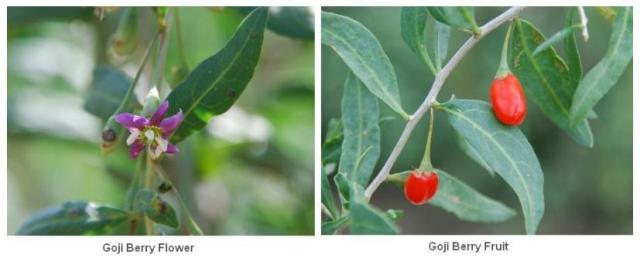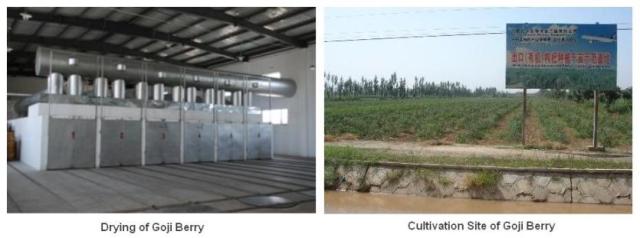SUN TEN Quarterly Newsletter Spring 2010: Goji Berry Cultivation Site Inspection
Lycium barbarum Linn. (Goji Berry) Cultivation Site Inspection
By Dr. Wu-chang Chuang
Deputy Director of Brion Research Institute of Taiwan
In recent years there has been an increase in concern in the international community regarding various issues of medicinal plants, including safety, correct species and place of origin. According to some reports there have been problems with pesticide residues as well as excessive sulfur residues found on Goji berries. In August of 2008, I personally went to the growing area of Goji berry in Ningxia to investigate the issue and found that indeed there are numerous problems with the Goji berry sold in marketplaces and herbs distribution centers.
The primary growing areas of Lycium barbarum Linn. are Zhongning and Zhongwei Counties, which are located in the river bend area of the Yellow River, the largest Goji berry growing area in China. Lycium barbarum Linn. must be cultivated for 2-3 years begin fruiting and harvesting. Between 4-8 years is the time of growing peak, while after 10 years fruiting begins to drop; this is the time when the root is harvested and use as Lycium Bark (Di Gu Pi) medicinal herb. Since the Tang dynasty work Xin Xiu Ben Cao (AD 659) and the Ming dynasty Ben Cao Pin Hui Jing Yao (AD 1505), Goji berry from Ganzhou and Ningxia regions have been considered to be the best quality.
In May of each year, small purple flowers begin to bloom which then develop into fruits. It takes a great amount of human labor to harvest Goji berry. >From mid June to mid July , it is the first harvest of spring fruits; this is followed by harvest of the summer fruits from mid July to mid August. These two harvests can also be collectively referred to as the summer fruits, which are large, good tasting, and of high quality. The summer fruit harvest is followed by a dormant period of about one month before the plants once again begin to flower and then from mid September to mid October begins the harvest of the autumn fruit, which tend to be smaller and not as good quality.
The outer surface of the Goji fruit has a waxy layer that prevents the loss of water when exposed to the sun. Consequently, it is difficult to dry the fruit by directly drying it in the sun. In most cases, the Goji berries are soaked in a solution of food grade sodium bicarbonate (baking soda) to remove the waxy coating before being dried in the sun. After removal of the waxy coating, the fruits are thoroughly dried in the sun (about 4-7 days) or after drying in the sun for about 3-5 days, then finished by using hot air or evaporation to dry.
I went to several cultivation sites for investigation and discovered most Goji farm plots were small, and the plants were planted very close together. Also neighboring farms plots of fruits and vegetables attracted pests, so chemical and pesticides were applied regularly leading to many instances of contamination. However, there are cultivation sites much less contaminations, the operations are appropriately managed, with large plots, more spacing between the plants, partial mechanization of cultivation and weed removal, and where organic fertilizers and biological pesticides were used.
Sun Ten specifically chooses Goji grown and processed in Zhongning county, Ningxia from properly managed large plots, inspecting for color, size, flavor, sulfur residue and pesticide residues, making sure they meet all our standards. These Goji is certified as Grade A by the China Organic Food Standards (LB-23-0707281670A)
Sun Ten has commissioned SGS Taiwan to test these Goji for the pesticides and heavy metals contaminants, the test results showed Sun Ten Goji are free of pesticides and heavy metals contaminations.
There are many purity problems with the Goji sold in the common and wholesale markets. However, there are still high quality, safe Goji (Lycium barbarum Linn.) available, through actual visit of the cultivation site to ensure that farms are properly managed and the appropriate processing methods are used.

